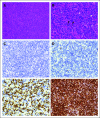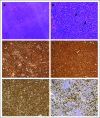Accuracy of Pathologic Diagnosis in Patients With Lymphoma and Survival: A Prospective Analysis From Botswana
- PMID: 34860565
- PMCID: PMC8654434
- DOI: 10.1200/GO.21.00209
Accuracy of Pathologic Diagnosis in Patients With Lymphoma and Survival: A Prospective Analysis From Botswana
Abstract
Purpose: With intense HIV epidemics, southern African countries have a high burden of classic Hodgkin lymphoma (CHL) and non-Hodgkin lymphoma (NHL). However, suboptimal access to pathology resources limits subtype classification. We sought to assess the diagnostic accuracy of specimens classified as lymphoma and to determine association between discordant pathologic diagnosis and overall survival.
Methods: Seventy patients with CHL or NHL and treated at three Botswana hospitals from 2010 to 2016 were analyzed. Local pathologic assessment relied primarily on morphology. All cases underwent secondary US hematopathology review, which is considered gold standard.
Results: The median follow-up was 58 months. The overall reclassification rate was 20 of 70 cases (29%). All 20 CHL cases were correctly classified in Botswana, and mixed cellularity was the most common subtype, diagnosed in 11 (55%) cases. Of 47 confirmed NHL cases, diffuse large B-cell lymphoma was the final US diagnosis in 28 cases (60%), another aggressive B-cell NHL in nine (19%), an indolent B-cell NHL in six (13%), and T-cell NHL in four (9%). Common types of diagnostic discordance included NHL subtype reclassification (11 of 20, 55%) and CHL reclassified as NHL (7 of 20, 35%). Concordant versus discordant diagnosis after secondary review was associated with improved 5-year overall survival (60.1% v 26.3%, P = .0066). Discordant diagnosis was independently associated with increased risk of death (adjusted hazard ratio 2.733; 95% CI, 1.102 to 6.775; P = .0300) even after stratifying results by CHL versus NHL.
Conclusion: In this single prospective cohort, discordant pathologic diagnosis was associated with a nearly three-fold increased risk of death. Limited access to relatively basic diagnostic techniques impairs treatment decisions and leads to poor patient outcomes in low-resource countries.
Conflict of interest statement
Figures




References
-
- Country Factsheets: Botswana 2018. https://www.unaids.org/en/regionscountries/countries/botswana
-
- Rogena EA, De Falco G, Schurfeld K, et al. : A review of the trends of lymphomas in the equatorial belt of Africa. Hematol Oncol 29:111-115, 2011 - PubMed
-
- Perry AM, Perner Y, Diebold J, et al. : Non-Hodgkin lymphoma in Southern Africa: Review of 487 cases from the International Non-Hodgkin Lymphoma Classification Project. Br J Haematol 172:716-723, 2016 - PubMed
Publication types
MeSH terms
Grants and funding
LinkOut - more resources
Full Text Sources
Medical

